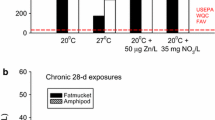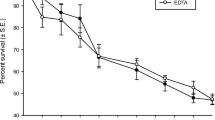Abstract
This study evaluated the combined effect of pH and metals on the egg fertilization process of two estuarine species, the blue mussel (Mytilus edulis), the oyster (Crassostrea gigas) and a marine species, the sea urchin (Paracentrotus lividus). The success of egg fertilization was examined after exposure of gametes to sediment extracts of various degrees of contamination at pH 6.0, 6.5, 7.0, 7.5 and 8.0. At the pH levels from 6.5 to 8.0, the egg fertilization of the different species demonstrated different sensitivity to metal and/or acidic exposure. In all species, the results revealed that egg fertilization was almost completely inhibited at pH 6.0. The egg fertilization of the blue mussel M. edulis was the least sensitive to the exposure while that of the sea urchin P. lividus demonstrated a concentration-dependent response to the pH levels from 6.5 to 8.0. The results of this study revealed that acidity increased the concentration of several metal ions (Cr, Ni, Cu, Zn, Cd, and Pb) but reduced its availability to the organisms, probably related to the reactivity of the ions with most non-metals or to the competition among metals and other waterborne constituents.








Similar content being viewed by others
References
Allison N, Millward GE, Jones MB (1998) Particle processing by Mytilus edulis: effects on bioavailability of metals. J Experiment Mar Biol Ecol 222:149–162
Amachree D, Moody AJ, Handy RD (2013) Comparison of intermittent and continuous exposures to cadmium in the blue mussel, Mytilus edulis: accumulation and sub-lethal physiological effects. Ecotoxicol Environ Saf 95:19–26
Amiard JC, Geffard A, Amiard-Triquet C, Crouzet C (2007) Relationship between the lability of sediment-bound metals (Cd, Cu, Zn) and their bioaccumulation in benthic invertebrates. Estuar Coast Shelf Sci 72:511–521
Barros J, Sobral P, Range P, Chicharo L, Matias D (2013) Effects of sea-water acidification on fertilization and larval development of the oyster Crassostrea gigas. J Experiment Mar Biol Ecol 440:200–206
Barry JP, Buck KR, Lovera CF, Kuhnz L, Whaling PJ, Peltzer ET, Walz P, Brewer PG (2004) Effects of direct ocean CO2 injection on deep-sea meiofauna. J Atmos Ocean Technol 60:759–766
Basallote MD, De Orte MR, DelValls TA, Riba I (2014) Studying the effect of CO2-induced acidification on sediment toxicity using acute amphipod toxicity test. Environ Sci Technol 48(15):8864–8872
Baussant T, Ortiz-Zarragoitia M, Cajaraville MP, Bechmann RK, Taban IC, Sanni S (2011) Effects of chronic exposure to dispersed oil on selected reproductive processes in adult blue mussels (Mytilus edulis) and the consequences for the early life stages of their larvae. Mar Pollut Bull 62:1437–1445
Bellas J, Granmo A, Beiras R (2005) Embryotoxicity of the antifouling biocide zinc pyrithione to sea urchin (Paracentrotus lividus) and mussel (Mytilus edulis). Mar Pollut Bull 50:1382–1385
Bervoets L, Blust R (2000) Effects of pH on cadmium and zinc uptake by the midge larvae Chironomus riparius. Aquatic Toxicol 49:145–157
Boudouresque CF, Verlaque M (2013) Sea Paracentrotus lividus. In: Lawrence JM (ed) Sea urchins: biology and ecology. Developments in Aquaculture and Fisheries Sci 38:297–327
Casado-Martinez MC, Forja JM, DelValls TA (2007) Direct comparison of amphipod sensitivities to dredged sediments from Spanish ports. Chemosphere 68:677–685
Chapman PM, Wang F, Caeiro SS (2013) Assessing and managing sediment contamination in transitional waters. Environ Int 55:71–91
Dupont S, Olga-Martínez O, Thorndyke M (2010) Impact of near-future ocean acidification on echinoderms. Ecotoxicology 19:449–462
Feely RA, Alin SR, Newton J, Sabine CL, Warner M, Devol A, Krembs C, Maloy C (2010) The combined effects of ocean acidification, mixing, and respiration on pH and carbonate saturation in an urbanized estuary. Estuar Coast Shelf Sci 88:442–449
Geraci F, Pinsino A, Turturici G, Savona R, Giudice G, Sconzo G (2004) Nickel, lead, and cadmium induce differential cellular responses in sea urchin embryos by activating the synthesis of different HSP70s. Biochem and Biophys Res Comm 322:873–877
Grout JA, Levings CD (2001) Effects of acid mine drainage from an abandoned copper mine, Britannia Mines, Howe Sound, British Columbia, Canada, on transplanted blue mussels (Mytilus edulis). Mar Environ Res 51:265–288
Halsband C, Kurihara H (2013) Potential acidification impacts on zooplankton in CCS leakage scenarios. Mar Pollut Bull 73:495–503
Herman PMJ, Heip CHR (1999) Biogeochemistry of the MAximum TURbidity Zone of Estuaries _MATURE/: some conclusions. J Mar Syst 22:89–104
Huesemann MH, Skillman AD, Crecelius EA (2002) The inhibition of marine nitrification by ocean disposal of carbon dioxide. Mar Pollut Bull 44:142–148
Intergovernmental Panel on Climate Change (IPCC) (2007) Climate change 2007: the fourth assessment report of the IPCC. Cambridge University Press, Cambridge
Khosrovyan A, Rodriguez-Romero A, Salamanca MJ, DelValls TA, Riba I, Serrano F (2013) Comparative performances of eggs and embryos of sea urchin (Paracentrotus lividus) in toxicity bioassays used for assessment of marine sediment quality. Mar Pollut Bull 70:204–209
Khosrovyan A, Rodriguez-Romero A, Ramos MA, DelValls TA, Riba I (2015) Comparative analysis of two weight-of-evidence methodologies for integrated sediment quality assessment. Chemosphere 120:138–144
Komjarova I, Blust R (2009) Effect of Na, Ca and pH on simultaneous uptake of Cd, Cu, Ni, Pb, and Zn in the water flea Daphnia magna measured using stable isotopes. Aquatic Toxicol 94:81–85
Kurihara H, Kato S, Ishimatsu A (2007) Effects of increased seawater pCO2 on early development of the oyster Crassostrea gigas. Aquatic Biol 1:91–98
Moulin L, Catarino AI, Claessens T, Dubois P (2011) Effects of seawater acidification on early development of the intertidal sea urchin Paracentrotus lividus (Lamarck 1816). Mar Pollut Bull 62:48–54
Mount DR, Mount DI (1992) A simple method of pH control for static and static-renewal aquatic toxicity tests. Environ Toxicol Chem 11:609–614
Mukherjee DP (2014) Dynamics of metal ions in suspended sediments in Hugli estuary, India and its importance towards sustainable monitoring program. J Hydrobiol 517:762–776
Pagano G, Esposito A, Bove P, de Angelis M, Rota A, Vamvakinos E, Giordano GG (1982a) Arsenic-induced developmental defects and mitotic abnormalities in sea-urchin development. Mutation Res 104:351–354
Pagano G, Esposito A, Giordano GG (1982b) Fertilization and larval development in sea Urchins following exposure of gametes and embryos to cadmium. Arch Environ Contam Toxicol 11:47–55
Paquin PR, Gorsuch JW, Apte S, Batley GE, Bowles KS, Campbell PGC, Delos CG, Di Toro DM, Dwyer RL, Galvez F (2002) The biotic ligand model: a historical overview. Comp Biochem Physiol C 133:3–35
Riabowol KT, Mizzen LA, Welch WJ (1988) Heat shock is lethal to fibroblasts microinjected with antibodies against hsp70. Sci 242(4877):433–436
Riba I, DelValls TA, Forja JM, Gomes-Parra A (2002) Influence of the Aznalcollar mining spill on the vertical distribution of heavy metals in sediments from the Guadalquivir estuary (SW Spain). Mar Pollut Bull 44:39–47
Riba I, DelValls TA, Forja JM, Gomes-Parra A (2004) The influence of pH and salinity on the toxicity of heavy metals in sediment to the estuarine clam Ruditapes philippinarum. Environ Toxicol Chem 23(5):1100–1107
Rodriguez-Romero A, Khosrovyan A, DelValls TA, Obispo R, Serrano F, Conradi M, Riba I (2013) Several benthic species can be used interchangeably in integrated sediment quality assessment. Ecotoxicol Environ Saf 92:281–288
Santore RC, Mathew R, Paquin PR, Di Toro D (2002) Application of the biotic ligand model to predicting zinc toxicity to rainbow trout, fathead minnow, and Daphnia magna. Comp Biochem Physiol C 133:271–285
Thomson J (1985) Cellular metal distribution in the pacific oyster, Crassostrea gigas (Thun.) determined by quantitative X-ray microprobe analysis. J Exp Mar Biol Ecol 85:37–45
Turner A, Rawling C (2001) The influence of salting out on the sorption of Neutral organic compounds in estuaries. Wat Res 35(18):4379–4389
Turner A, Barrett M, Brown MT (2009) Processing of antifouling paint particles by Mytilus edulis. Environ Pollut 157:215–220
USEPA (1992) Ground water issue. Behavior of metals in soils. EPA/540/S-92/018. http://www.epa.gov/superfund/remedytech/tsp/download/issue14.pdf. Accessed 1 December 2014
USEPA (1998) Evaluation of dredged material proposed for discharge in waters of the U.S. testing manual inland testing manual., Accessed 20 December 2014
USEPA (2012) National recommended water quality criteria. http://water.epa.gov/scitech/swguidance/standards/criteria/current/index.cfm. Accessed 1 January 2014
Volpi Ghirardini T, Arizzi Novelli A, Tagliapietra D (2005) Sediment toxicity assessment in the Lagoon of Venice (Italy) using Paracentrotus lividus (Echinodermata: Echinoidea) fertilization and embryo bioassays. Environ Int 31:1065–1077
Wei L, Wang Q, Wu H, Ji C, Zhao J (2015) Proteomic and metabolomic responses of Pacific oyster Crassostrea gigas to elevated pCO2 exposure. J Proteomics 112:83–94
Wong JL, Wessel GM (2005) Reactive oxygen species and Udx1 during early sea urchin development. Dev Biol 288:317–333
Wood HL, Spicer JI, Widdicombe S (2008) Ocean acidification may increase calcification rates, but at a cost. Proc R Soc B, http://dx.doi.org/10.1098/rspb.2008.0343
Author information
Authors and Affiliations
Corresponding author
Additional information
Responsible editor: Thomas Hutchinson
Rights and permissions
About this article
Cite this article
Riba, I., Gabrielyan, B., Khosrovyan, A. et al. The influence of ph and waterborne metals on egg fertilization of the blue mussel (Mytilus edulis), the oyster (Crassostrea gigas) and the sea urchin (Paracentrotus lividus). Environ Sci Pollut Res 23, 14580–14588 (2016). https://doi.org/10.1007/s11356-016-6611-7
Received:
Accepted:
Published:
Issue Date:
DOI: https://doi.org/10.1007/s11356-016-6611-7




